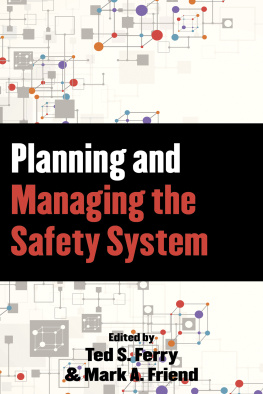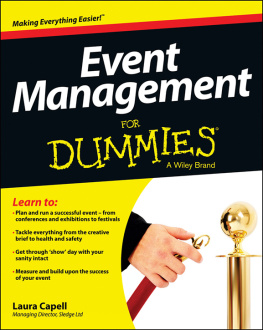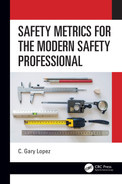Planning and Managing the Safety System
Planning and Managing the Safety System
Edited by
Ted S. Ferry and Mark A. Friend

Lanham Boulder New York London
Published by Bernan Press
An imprint of The Rowman & Littlefield Publishing Group, Inc.
4501 Forbes Boulevard, Suite 200, Lanham, Maryland 20706
www.rowman.com
800-865-3457; info@bernan.com
Unit A, Whitacre Mews, 26-34 Stannary Street, London SE11 4AB
Copyright 2017 by Bernan Press
All rights reserved. No part of this book may be reproduced in any form or by any electronic or mechanical means, including information storage and retrieval systems, without written permission from the publisher, except by a reviewer who may quote passages in a review.
British Library Cataloguing in Publication Information Available
Library of Congress Cataloging-in-Publication Data
Names: Ferry, Theodore S., editor. | Friend, Mark A., editor.
Title: Planning and managing the safety system / [edited by] Theodore S. Ferry and Mark A. Friend.
Description: Lanham : Bernan Press, [2017] | Includes bibliographical references and index.
Identifiers: LCCN 2016045136 (print) | LCCN 2016046091 (ebook) | ISBN 9781598887747 (cloth : alk. paper) | ISBN 9781598887754 (Electronic)
Subjects: | MESH: Safety Management
Classification: LCC R859.7.S43 (print) | LCC R859.7.S43 (ebook) | NLM WA 485 | DDC 610.28/9dc23
LC record available at https://lccn.loc.gov/2016045136
 The paper used in this publication meets the minimum requirements of American National Standard for Information SciencesPermanence of Paper for Printed Library Materials, ANSI/NISO Z39.48-1992.
The paper used in this publication meets the minimum requirements of American National Standard for Information SciencesPermanence of Paper for Printed Library Materials, ANSI/NISO Z39.48-1992.
Printed in the United States of America
Contents
Mark A. Friend, Tracy L. Zontek, and Burton R. Ogle
Mark A. Friend
Mark A. Friend
Kathy S. Friend and Mark A. Friend
Mark A. Friend
Mark A. Friend
Mark A. Friend
Mark A. Friend
Mark D. Hansen
Mark D. Hansen
Henry A. Walters
Mark A. Friend
Mark D. Hansen
Michael OToole
Tracy L. Zontek and Burton R. Ogle
Tracy L. Zontek and Burton R. Ogle
Tracy L. Zontek and Burton R. Ogle
Kimberlee K. Hall
Tracy L. Zontek and Kimberlee K. Hall
Working on this text has been a privilege. Theodore (Ted) Ferry was instrumental in helping me obtain my doctorate from West Virginia University (WVU). As a fellow West Virginian from nearby Clarksburg, Ted was directed to me by the chair of the Safety Studies Department at WVU, Dr. C. Everett Marcum. At the time Ted was working at the University of Southern California in their Aerospace Institute of Safety and Management. Dr. Marcum also helped me enlist some other premier safety professionals, including Fred Manuele, whom I have come to highly respect professionally and personally; Mr. William Tarrants, whom I became acquainted through a series of site visits with NIOSH; Frank Bird, Jr., whom I knew through interactions at various professional conferences; William Pope, another well-respected author of safety material; Dr. Julius Morris, professor at the University of Hawaii; and Jim Findlay, a Canadian engineer and safety expert. Discussing philosophies and beliefs with these safety giants greatly impacted my beliefs regarding safety and the overall approach I took. Hopefully, it has also had an impact on the many students Ive taught at WVU, Murray State University, East Carolina University, and Embry-Riddle Aeronautical University.
I began using his text at WVU and again at Murray State. After reviewing as many texts as I could find on the topic of safety management, I realized that Ferrys text was, by far, superior to the rest in the field. I adopted the book and required it of all students in the MS program at Murray. After his passing, I was very disappointed at his absence and the fact that he was no longer available to revise the text. In the late 1990s Dr. Jim Kohn, a great friend and colleague, updated the book with some of the best minds in the field. The text he did is still relevant and helpful to all who use it. My personal approach was a little different. Ferrys original text emphasized safety management systems, but when the book was originally written, this concept was simply referred to as system safety. In this current rewrite, my colleagues and I have taken Ferrys approach and updated it to reflect the latest research and materials available in safety management systems (SMS). We tie much of the book to SMS and provide more of a management and technical safety background than is usually found in books or articles related to SMS.
The book initially provides a background on how the overall field of safety began abroad and eventually developed in the United States. Following that description is an overview of the field of safety, as it exists today. From there, we addressed the basic management functions, including planning, organizing, directing, controlling, and staffingas they relate to SMS. All of this is placed within the safety management or SMS framework, as is addressed in various regulations and standards. Following the discussion of management applications, the book explores key safety topics from an SMS perspective, including accident investigation, recordkeeping, industrial hygiene, wellness, emergency response, hazardous materials, and radiation. These are areas often dealt with by the safety professional and members of the safety team. We really attempted to provide a document useful to current safety professionals and soon-to-be professionals in colleges and universities. Thank you Ted Ferry.
Many thanks to the authors who contributed to this bookin both its original and revised editions. Thanks also to my former professors and colleagues in the former Department of Safety Studies at West Virginia University and faculty at Murray State University and Embry-Riddle Aeronautical University. Special thanks also extend to Dr. James (Jim) P. Kohn, a former long-time friend and colleague at East Carolina University. Of course, I owe a debt of gratitude to Ted Ferry, who provided input and insight into my doctoral dissertation and wrote the early editions of this text. Sincere thanks and appreciation to my wife Kathy, who provides inspiration and support in all our professional endeavors.
Mark A. Friend, Tracy L. Zontek, and Burton R. Ogle
CASE
Mike Williams investigated a fatality in his company where a worker was assigned to clean filters in a process involving relatively high temperatures. There were six filters accessed by a walkway on the first floor and overhead walkways on the second and third. The rest area and water fountains were on the first floor. The second two floors had no place to sit or take a break. The area of work was often over 100 F, so employees were instructed to take frequent breaks, and drink lots of fluids. It was near the end of the work shift on a hot summer day, and Jim Hunt, an older worker with a history of heart disease, was hurrying to complete his task. He completed the cleaning process for all eighteen filters and punched the time clock to leave at 3:30 p.m., right on time. When he approached the gate, he stopped his vehicle and slumped over the steering wheel. The guard was unable to revive him, so he called 911. Jim was pronounced dead on arrival at the local hospital. The cause of death was a heart attack. In spite of OSHA requirements, the accident was not reported, since the death occurred after work hours. Following the investigation, Mike Williams reported the fatality was after hours and completely the fault of the employee, since he did not follow instructions in terms of taking appropriate breaks and drinking lots of fluids.
Next page







 The paper used in this publication meets the minimum requirements of American National Standard for Information SciencesPermanence of Paper for Printed Library Materials, ANSI/NISO Z39.48-1992.
The paper used in this publication meets the minimum requirements of American National Standard for Information SciencesPermanence of Paper for Printed Library Materials, ANSI/NISO Z39.48-1992.